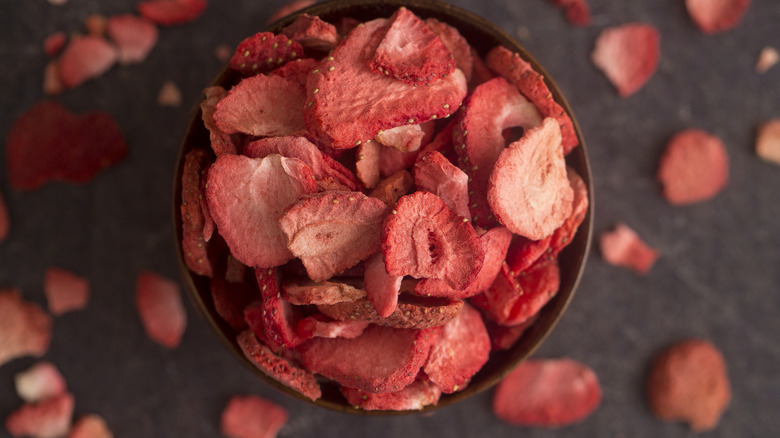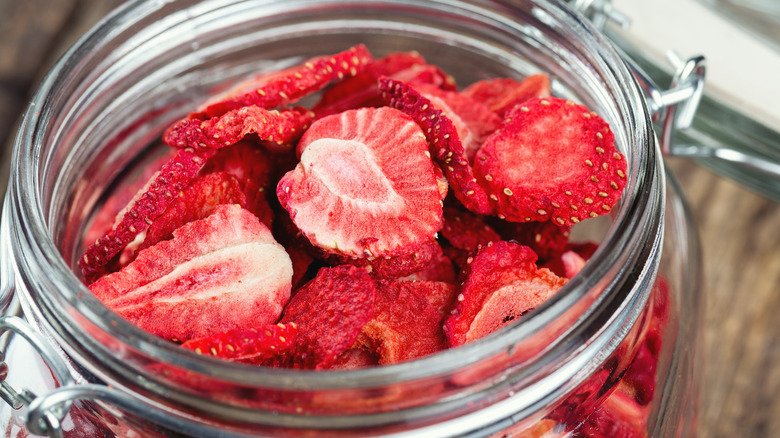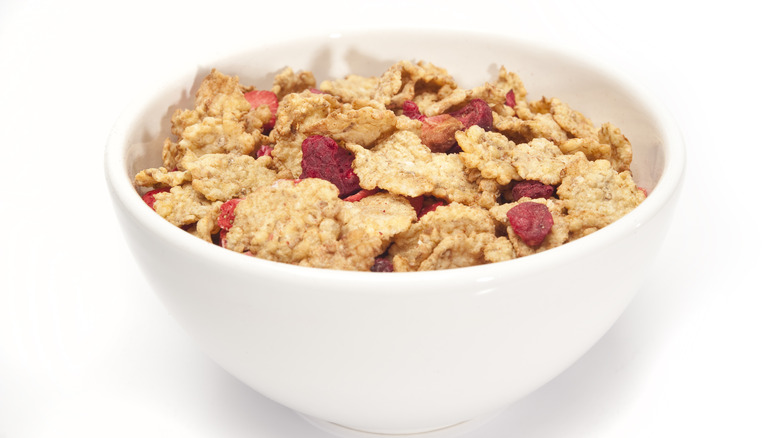The Jar Test To Ensure Strawberries Are Fully Dehydrated
Raisins seem to get all the love in the dried fruit section, but dehydration is one of the most fun ways to enjoy so many of nature's sweet gems. Once dehydrated, fruit can take on a chewy and delightful consistency similar to gummy candies. Dry them a little further, and you have the crispy, delicious bits much like what you might find in your favorite breakfast cereal. Endlessly versatile, DIY dried fruit is super easy to accomplish right at home.
When it comes to fruit selection, strawberries are an attractive candidate for dehydration. Given their short season — only about three weeks — this process is an ideal way to stretch your strawberry stash for several months. Once fully dried, strawberries — which stay vibrant and red (unlike fruits like pears and apples, which oxidize with the drying process) — can be kept in an airtight container for a full year.
That said, when dehydrating at home, it can be tough to determine when your berries have become dry enough to have that shelf stability. For safety's sake, you'll want your berries to be at 20% moisture, but without the scientific gear to guarantee that exact figure, a simple test can tell you if your strawberries are in shelf-stable shape. All it requires is a jar and some time. Simply store your dehydrated berries in a jar for about a week to 10 days, and periodically give the container a shake. If no moisture or condensation appears, your fruit is adequately dried.
How to jar test your dried berries
This process, called "conditioning," is a snap — and a crucial step to enjoying your strawberries safely. To start, go through the standard procedure of dehydrating your berries. Select ripe berries, then wash, hull, dry, and slice them about ⅛ to ½ inch thick (just allot extra time for thicker slices, if that's your preference). Set your dehydrator to 135 degrees Fahrenheit and arrange the berries on your trays in a single, even layer. It should take about 7 to 15 hours, depending on whether you'd like them more chewy or crisp.
Once you have your berries to your desired level of dryness, you can go ahead with the test. Fill a jar or air-tight container with your dried fruit, leaving some space — about ⅔ full should do it. If you do see beads of moisture appear in the jar in that week-long period, never fear — a few more hours in the dehydrator will get you to the finish line. Just repeat the test afterward to be sure. Once you're certain your berries are ready to go, you can even stretch the shelf life of these little bites of goodness a bit longer by storing them cold, either in the fridge or freezer, so they'll be ready whenever inspiration strikes.
Handy ways to use your dried strawberries
Once you have these fruity flavor bursts fully dehydrated and ready to go, you can get super creative with how you use them. In the morning, toss them in your cereal for an at-home take on popular supermarket brands. You can even make your own flake-like breakfast bits flecked with your dried strawberries. They also make a perfect mix-in for your scone or muffin batter, as well as an ideal addition to homemade granola or strawberry granola bars for snacking on the go.
Dehydrated fruit substitutes well in many places you might otherwise use fresh fruit. For lunchtime, a strawberry spinach salad with chicken is a nutritious workday break made possible anytime of the year with your dried berries. You can even have pizza night with strawberry goat cheese pizza and a drizzle of balsamic. And of course, dessert options abound. You can keep it classic with a spin on strawberry shortcake, or — if your berries are on the crispy dried side, pulverize them into a powder and combine it with flour for an eye-catching pink cake or batch of cookies that just can't be done with fresh berries.


